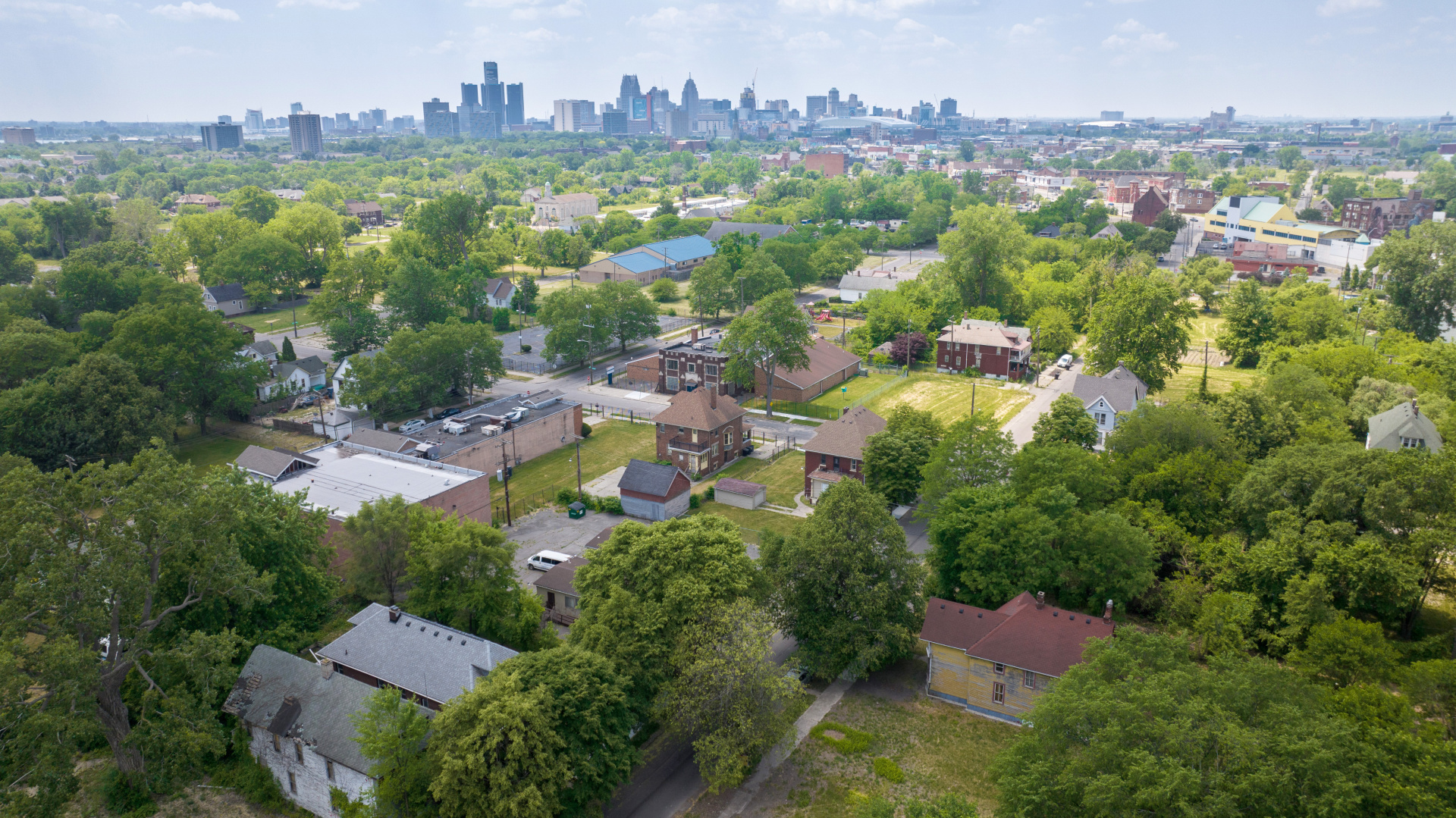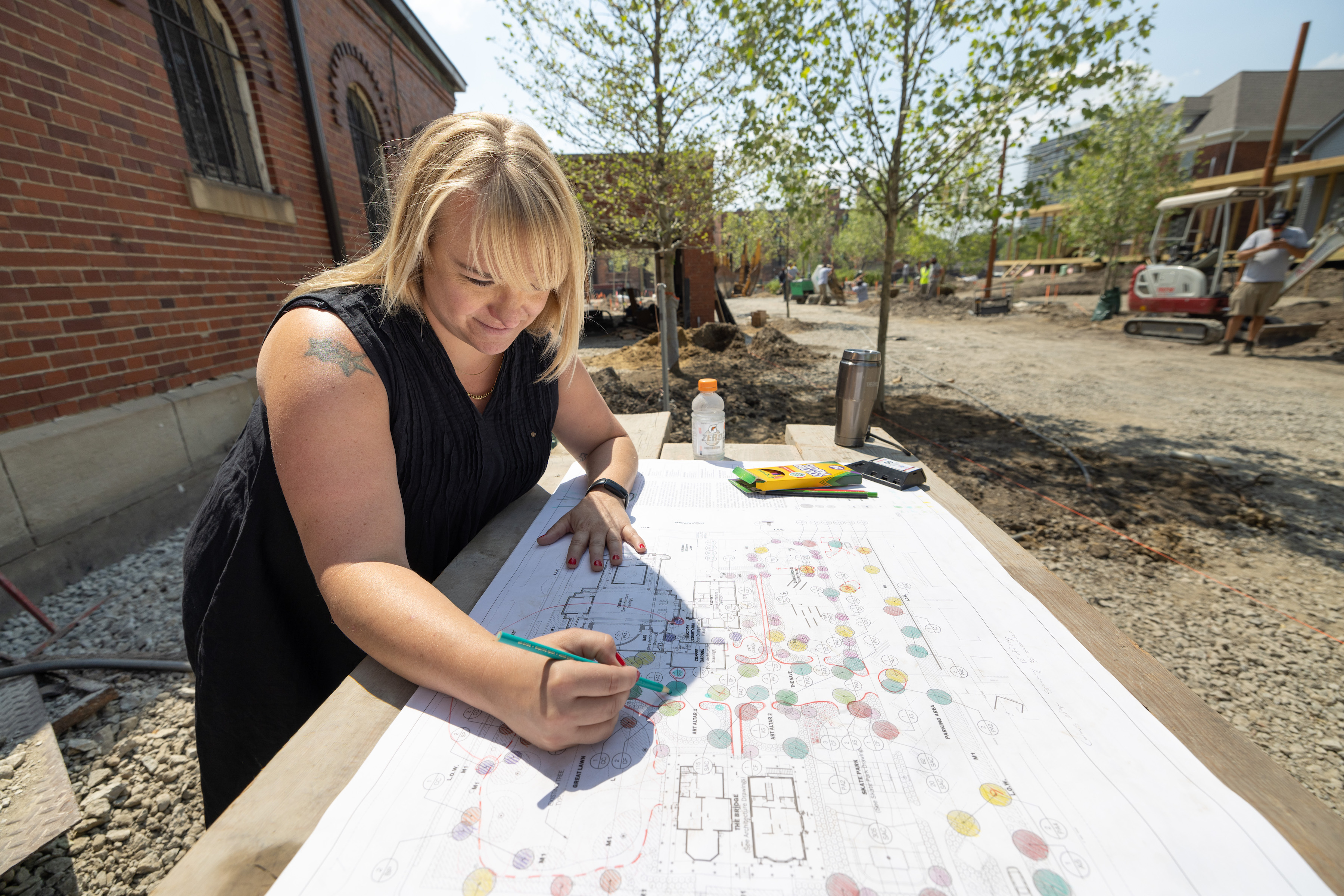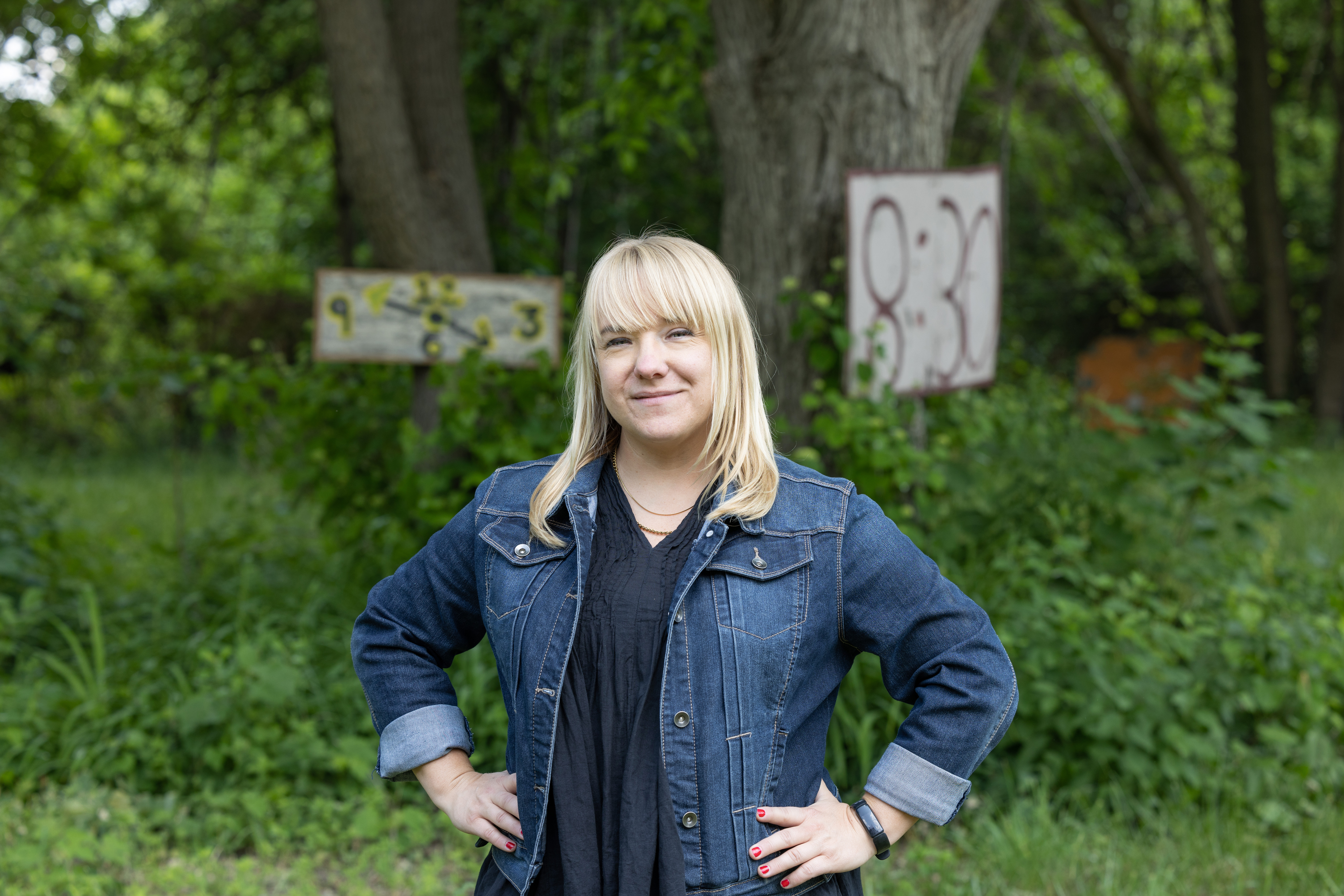
Meet the Future: Transforming Vacant Land in Detroit
Empowering communities to reimagine the city
It has been a decade since Detroit’s historic bankruptcy, and although the signs of recovery are palpable throughout Downtown, Midtown, Corktown, New Center and the Riverfront—with clear signs of private investment and development—there exists a different reality when you leave these more central parts of the city. An estimated 19 square miles of vacant land remain scattered throughout Detroit, representing unique opportunities and complex challenges. Who acquires this vacant land and how it is transformed holds the potential to empower communities to reinvent the future of Detroit, something that University of Michigan School for Environment and Sustainability (SEAS) Assistant Professor of Practice in Landscape Architecture Lisa DuRussel (BS ’02, MLA ’06), alongside her students and community collaborators, is passionate about ensuring.
“We work closely with the residents of Detroit to make sure they have a say in what happens to this vacant land, and we don’t want our work to just sound great on paper, we want it to be what the community needs,” says DuRussel. “So, we really put a lot of focus on being present in the communities and listening carefully to residents so we can provide the right help.”
With her grassroots, ground-up approach, DuRussel believes strongly in forging relationships with local community members and leaders, and she has done just that since joining SEAS in 2020—building rapport by being present and putting power into the hands of the residents while leveraging U-M resources to support their visions. The trust she has built has allowed DuRussel to integrate her deep connections into the projects she designs for her students. She says that these projects tend to attract SEAS students who are interested in both community engagement and the questions surrounding the future of vacant land in Detroit.
Helping Detroiters acquire and plan for vacant land
One recent master’s project that DuRussel facilitated, dubbed Greenprint Detroit, gave both DuRussel and her students the opportunity to practice being present and listening to residents’ needs and has inspired many more community engagement-related projects. The project, which concluded in 2022, aimed to help the residents of Detroit navigate the land acquisition process through the Detroit Land Bank Authority (DLBA). This public authority has owned and managed around 100,000 parcels of property in Detroit consisting of vacant lots and abandoned houses, in addition to other structures that were forced into tax foreclosure. They sell property through multiple programs, such as the “Side Lot Program,” which allows residents living next door to or across the street from publicly owned vacant lots the opportunity to purchase them for $100.
But the DLBA and the way it operates has faced some criticism, with one of the major issues that Detroiters have spoken out on being that they have difficulty effectively navigating the property buying process through DLBA. For example, it is a requirement when purchasing land through DLBA to propose a plan that lays out how the land will be used and transformed within six months of acquiring the property. Creating such a plan can be a complex process, and while there are several organizations in Detroit that offer premade plans, many of them are designs that are far too expensive for residents to follow through on.
This is what inspired the Greenprint Detroit project team to work with community members to create a thoughtful, useful and realistic toolkit on how to attain and transform vacant land. The toolkit offers a blueprint of sorts, with plans that take climate adaptation into consideration by “decolonizing lawns,” meaning planting meadows or rain gardens that improve infiltration and aid in stormwater management so that the landscapes can better handle extreme weather events, in addition to being welcoming to wildlife.

“A lot of the premade plans that were available to residents were amazing $100K landscapes, but that doesn’t match the need of most Detroiters acquiring vacant land. Most residents have enough funding to create a community or urban garden, so what we realized is that we needed to be field catalysts and work more one-on-one with residents to hear their visions and then help them either draft their own plan or create one for them,” says DuRussel.
The resulting toolkit offered pre-designed renovation options that came with cost estimates. “Someone could just rip a page out of the book and submit it to DLBA and say, here is my plan. So, the bulk of the work is done,” says DuRussel. DuRussel adds that having a plan in hand also allows residents to more easily file for a permit with the city to zone the lot from vacant to something else, such as an urban garden or an orchard.
Empowering local communities in the revitalization of vacant land
The success of the Greenprint Detroit project has spurred several other projects that DuRussel is developing. She believes that the work that students can contribute to communities in Detroit can have a great impact. “These projects have been perfect for students who are interested in one-off projects with communities and nonprofits in Detroit. They need support—they don’t have the funding and time and capacity to do some of the work they want to do—but their success is so important. Residents reach out to me and I often pair them with a student to help them realize their ideas.”
One such client was Tanya Stephens, who founded and runs Detroit Vacant Land CDC, a community development organization dedicated to the preservation, beautification and activation of vacant land in Detroit. Stephens, who launched the nonprofit in 2020, just months into the COVID-19 pandemic, was interested in finding ways to repurpose green space for safe social distancing. But, ultimately, realizing the abundance of underutilized land, her vision was to support residents in reclaiming land in their communities by offering a range of resources for creative uses, such as community gardens, urban farms and art parks.
Stephens’ work has since evolved and grown to include transforming vacant land through historic property rehabilitation as well as creative placemaking, which aims to strengthen communities by integrating arts, culture and design activities. She recently acquired some land and an abandoned home in the McDougall-Hunt neighborhood near the revered Heidelberg Project—an outdoor art environment that is itself a vacant land transformation project that has attracted hundreds of thousands of visitors each year. Here, Stephens plans to build a creative incubator and membership residency for artists, designers, visionaries and innovators. She calls this project the “House of Imagination and Gardens,” and says she wants her work to positively impact the evolution of the neighborhood.
“I want to continue to develop the legacy and build on the blueprint created by the visionary artist behind the Heidelberg Project, Tyree Guyton, by utilizing arts, culture, design and imagination as a catalyst for neighborhood revitalization,” says Stephens. “My goal is to help the community reimagine what a stabilized and regenerative community can look like aside from abandonment. What’s the opposite of that? I envision a fully developed neighborhood that’s beautiful and welcoming, combining housing and diverse green spaces. Hopefully, this corridor can be like an arts district that can embrace all of the different attributes of the block and the entire Detroit community.”
With her goals of transforming the vacant land near the Heidelberg Project in mind, Stephens approached DuRussel for help in making sure that the soil on her properties was safe for agriculture and supporting native species and habitats. “Lisa and her team of students were able to do soil tests on our sites and also design a plot plan,” says Stephens. “They did an amazing job, and I was relieved that no major contaminants were found so I could safely proceed with my plan to create a robust community garden and functional green spaces.”
While this type of one-on-one, pro bono work comes up frequently, DuRussel and her students have also found ways to help larger groups of people. Stephens is working on a new concept in collaboration with DuRussel, Detroit Land Lab, which will provide a range of educational opportunities on “eco-literacy,” such as help with landscape design, plant identification and soil testing, to empower residents to not just acquire land but to preserve, beautify and activate it. DuRussel’s students will be involved with this effort, which has been awarded an Engage Detroit Workshops grant, in addition to organizing workshops in various neighborhoods around Detroit.
These workshops, which focus on specific topics related to vacant land, have grown very popular, with DuRussel working to schedule as many as she can. “What we’ve uncovered is that the residents and nonprofits want to build capacity. But wouldn’t it be awesome if we taught people how to do this themselves? McDougall-Hunt, a neighborhood with more vacancies than residents, is putting in a tech hub with computers and workstations, so when it’s open, we’re going in to do office hours to help do more formalized training for visualization using apps and open-source tools to help people make their own renderings.”

Future projects to help build the Detroit of tomorrow
DuRussel and her team, in partnership with the SEAS Detroit Sustainability Clinic, will embark on a new master’s project in Detroit with Cass Community Social Services (CCSS). The nonprofit agency has taken a different approach to transforming vacant land by creating a “tiny homes” neighborhood on the northwest side of the city. The community is designed to help residents, many of whom were formerly homeless, incarcerated, aged out of the foster care system or are senior citizens, improve their lives and provide a pathway to building generational wealth. The cost to live in a tiny home is $1/month per square foot for rent, which amounts to between $250-$400 a month. After seven years, residents have the opportunity to own the home.
CCSS has more land that they’d like to develop in a way that’s beneficial to the Detroit community, which could mean more tiny-homes neighborhoods. How this land is developed is something that DuRussel and her students will work on beginning with summer internships in 2023, funded by the SEAS Detroit Sustainability Clinic. The goal is to offer CCSS analysis, visioning and project outlines for their land. They plan to study the idea of creating a “green corridor” to include streetscape improvements and ideas for green and sustainable development, such as a no-waste grocery store and the integration of solar energy into the neighborhood.
One of the interns on the project team, Nana Temple, is a rising third-year Master in Landscape Architecture student at SEAS. She says that her interest in public spaces and how it benefits people emotionally and socially is what drew her to work with DuRussel.
“When I learned about Lisa and her community engagement work, I knew I wanted to be involved,” says Temple. “I’ve had a chance to work with her on workshops, do some pro bono work, and now I’m on the CCSS project. I am adamant about working in spaces that benefit communities and impact residents and neighborhoods in a way that’s socially innovative because I recognize that landscape architecture can be a conduit for social and environmental change.”
Temple described DuRussel’s work in Detroit as representative of effective and compassionate practice, where decisions aren’t made based on hierarchy, but rather through reciprocity and authentic relationship building. “With this project, we’d have an opportunity to learn about the needs of the community and do the research to help plan future work in the Dexter-Linwood neighborhood,” says Temple.
For DuRussel, her students and her partners in the community, these grassroots-driven and community-centered projects with an emphasis on sustainable choices that they’ve set in motion are key to transforming vacant land in Detroit. “There’s a saying, ‘Detroit Never Left.’ We need to support the people of this place and listen to them as we work to build the Detroit of tomorrow. It’s not just about the now, but what we’re passing on to future generations, and how,” says DuRussel. “Putting land back in the hands of the community is the first step in building the sustainable future of Detroit.”

